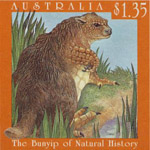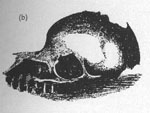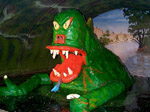
Part of aboriginal folklore, the Bunyip was a spirit, which inhabited the rivers, lakes, swamps and billabongs of Australia. The Bunyip was said to be malevolent towards humans and would defend its water home from anyone foolish enough to enter it.
At night the Bunyip was said to prey upon the women and children of aboriginal tribes. To the Aborigines the Bunyip was a beast of many different shapes and sizes. Some Bunyips were covered in feathers; some even had scales like crocodiles. Common features in most Aboriginal drawings of Bunyips are a horse-like tail, flippers, and tusks like the ones found on walruses.  Modern Bunyip’s, or at least those reported by the original settlers as well as today’s residence of Australia, vary greatly from the Bunyip in aboriginal stories. The aboriginal Bunyip was a fierce man killer where as the more modern view sees them as herbivorous grazing animals. During early settlement of Australia the notion that the Bunyip was an actual unknown creature awaiting discovery was widely held as truth.
Modern Bunyip’s, or at least those reported by the original settlers as well as today’s residence of Australia, vary greatly from the Bunyip in aboriginal stories. The aboriginal Bunyip was a fierce man killer where as the more modern view sees them as herbivorous grazing animals. During early settlement of Australia the notion that the Bunyip was an actual unknown creature awaiting discovery was widely held as truth.
Early European settlers were not accustom to the sights and sounds of the islands perculiar animal species regarded the Bunyip as one more strange Australian animal, and sometimes attributed unfamiliar calls or cries to it. In 1846 the discovery of a strange skull in an isolated area associated with these 'bunyip calls' seemed to provide physical evidence of the bunyip's existence.  The percular skull was found on the banks of Murrumbidgee River in New South Wales, several experts concluded the that skull was from a creature unknown to science. In 1847 the “Bunyip Skull” was put on exhibition at the Australian Museum in Sydney for two days. During the skull’s stay at the museum the Sydney Morning Herald reported a extreme increase in Bunyip sightings.
The percular skull was found on the banks of Murrumbidgee River in New South Wales, several experts concluded the that skull was from a creature unknown to science. In 1847 the “Bunyip Skull” was put on exhibition at the Australian Museum in Sydney for two days. During the skull’s stay at the museum the Sydney Morning Herald reported a extreme increase in Bunyip sightings.
It seemed that everyone became immediately aware that they had heard 'strange sounds' from the lagoons at night, or had seen 'something black' in the water. It was later concluded that the skull was nothing more than that of a disfigured horse or calf and disappeared from the museum soon afterwards.  Based on eye wittness reports there are two different kidns of Bunyip, the first being the more common, Dog Faced Bunyip, said to have a face like a dog and a shaggy coat, and the second being the Long Necked Bunyip, said to have a long haired mane and a similar shaggy coat. The Dog Faced Bunyip is thought to inhabit the lakes and rivers of New South Wales, Victoria and the Austrelian capital territory, there have even been sightings on the off shore island state of Tasmania. Reports of the rarer Long Necked Bunyip seem to only come from New South Wales.
Based on eye wittness reports there are two different kidns of Bunyip, the first being the more common, Dog Faced Bunyip, said to have a face like a dog and a shaggy coat, and the second being the Long Necked Bunyip, said to have a long haired mane and a similar shaggy coat. The Dog Faced Bunyip is thought to inhabit the lakes and rivers of New South Wales, Victoria and the Austrelian capital territory, there have even been sightings on the off shore island state of Tasmania. Reports of the rarer Long Necked Bunyip seem to only come from New South Wales.  Some researchers believe that the Bunyip may be a surviving Diprotodons, which was a large rhino sized plant eating marsupials, said to have gone extinct about 10,000 years ago. Much like reports of the modern Bunyip the Diprotodon was a grazing animal, the two also shared many of the same physical features.
Some researchers believe that the Bunyip may be a surviving Diprotodons, which was a large rhino sized plant eating marsupials, said to have gone extinct about 10,000 years ago. Much like reports of the modern Bunyip the Diprotodon was a grazing animal, the two also shared many of the same physical features.
The Diprotodon had a face somewhat like that of a dog, as well as a somewhat shaggy coat; both major traits of the Bunyip. Scientists who find this theory a little unlikely suggest that the Bunyip is nothing more than a seal, a common marine mammal found along the coasts of Australia.
These scientists suggest that the seals worked their way into the interior lakes and swamps through rivers only to be spotted by locals who where not accustom to seals and misidentify them as Bunyips. One thing is for certain, as long as there have been humans in Australia there have been sightings of the Bunyip and until there is a dedicated team of individuals willing to spend the time and money in search of this creature, it will remain a mystery.
The Physical Evidence
Beyond sightings of the Bunyip, and tales passed down by aboriginals, there remains no evidence of the existence of the Bunyip. Unfortunately, a lack of sightings in recent years has led some researches to believe that the Bunyip has gone extinct.
The Sightings
One morning in November 1821, E.S. Hall saw a Dog-faced Bunyip with jet-black hair in the marsh running into Lake Bathurst South, New South Wales.
In 1847 a young herdsmen saw a Long-necked Bunyip grazing while he was looking for some cows in a flooded area. A local settler, George Hobler, reported the young herdsman's story to the Sydney Morning Herald. According to the report made Hobler:
"It was about as big as a six months' old calf, of a dark brown color, a long neck, and long pointed head; it had large ears which pricked up when it perceived him (the herdsmen); had a thick mane of hair from the head down the neck, and two large tusks. He turned to run away, and this creature equally alarmed ran off too, and from glance he took at it he describes it as having an awkward shambling gallop; the forequarters of the animal were very large in proportion to the hindquarters, and it had a large tail."
He took two men to the place next morning to look for its track, which they described as broad and square, somewhat like what the spread hand of a man would make in soft muddy ground.
In 1852 a Dog-faced Bunyip was observed in Lake Tiberias, Tasmania. It was described as being 4 to 4˝ feet long, with a head like a bulldog and black shaggy fur. While rowing across Great Lake, Tasmania, Charles Headlam and a friend almost bumped into a Dog-faced Bunyip. They described it as being about the size of a fully-grown sheepdog, and having two small wing-like flippers. The Bunyip stayed at the top of the water until it swam out of view.
In 1872 three men watched a Dog-faced Bunyip swimming in Midgeon Lagoon, New South Wales for about a half-hour. One of the men gave the following first-hand description to the Wagga Wagga Advertiser: Half as long again as an ordinary retriever dog; the hair all over its body was jet-black and shining, its coat was very long, the hair spreading out on the surface of the water for about 5 inches, and floating loosely as the creature rose and fell by its own motion. I could not detect any tail, and the hair about its head was too long and glossy to admit of my seeing its eyes; the ears were well marked.
In 1886 some horsemen who were fording a river near Canberra reported seeing a Dog-faced Bunyip, which was about the size of a dog and had a white coat. They threw stones at the Bunyip until it was out of sight.
In 1890 a Bunyip with a white coat was shot at in New South Wales; it retreated into a lagoon and was said to make a grunting sound.
The Stats – (Where applicable)
• Classification: Unknown
• Size: About that of a large dog.
• Weight: Unknown
• Diet: Unknown
• Location: Australia and Tasmania
• Movement: Can Travel both on land and in water.
• Environment: Rivers, Marshes, Lakes, Swamps ad Billabongs.
|